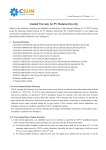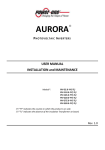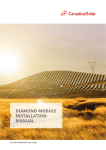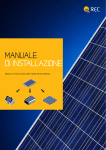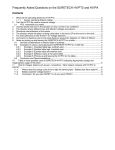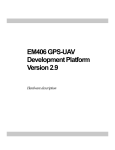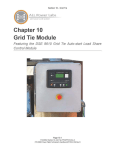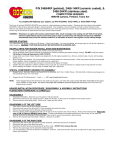Download Code Summary, Checklist, & Manual
Transcript
Code Corner Code Summary, Checklist, & Manual John Wiles Sponsored by the Photovoltaic Systems Assistance Center Sandia National Laboratories hotovoltaic (PV) power systems should be installed in accordance with the requirements of the National Electrical Code® (NEC®). The local authority having jurisdiction should inspect these systems. The owner should be able to operate the system and know when maintenance is required. P This Code Corner will look at the chapters and articles in the NEC, and describe how they apply to PV systems. A checklist is presented that may be used by PV installers and electrical inspectors. Finally, an abbreviated Owner/User Operations and Maintenance manual is presented for use with utilityinteractive PV systems. The Code The NEC is divided into nine chapters with numerous articles in each chapter. The first four chapters of the NEC are considered general chapters and apply to nearly all systems: Chapter 1—General Chapter 2—Wiring and Protection Chapter 3—Wiring Methods and Materials Chapter 4—Equipment for General Use Later chapters in the NEC cover specific installations, equipment, and conditions, and serve to modify and expand on the information in the first four chapters: Chapter 5—Special Occupancies Chapter 6—Special Equipment Chapter 7—Special Conditions Chapter 8—Communications Systems Chapter 9—Tables 130 Home Power #71 • June / July 1999 Article 90 Article 90 comes before Chapter 1 in the code. It is important because it describes what the code does and does not apply to. This article also discusses what information is mandatory, permissive, or explanatory. Chapter 1 Article 100 covers definitions of terms used in the code. These are necessary for understanding the requirements throughout the code. Article 110 establishes general requirements for all electrical installations. Many of the good workmanship requirements are found in this section. Chapter 2 Article 200 covers grounded conductors and the required color codes for these conductors. Articles 210, 215, 220, 225, and 240 cover circuit requirements and are applicable to both AC and DC circuits. Article 240 covers overcurrent devices and is particularly important to PV systems with multiple power sources and high available short-circuit currents from battery banks. Article 250 contains the grounding requirements and was completely revised in the 1999 NEC. Part H in the 1999 NEC, starting with Section 250-160, covers the grounding requirements for DC circuits. Article 280 covers the requirements for surge arrestors. Chapter 3 Article 300 covers wiring methods. This is a meaty chapter of the code and contains most of the wiring methods that are used in PV systems as well as the ampacity tables for conductors (Article 310). Both multiconductor cables and individual cables in various types of raceways are covered in this chapter. The last few articles in this chapter cover the size and conductor limitation requirements associated with outlet boxes, pull boxes, and panel boards. Chapter 4 In Chapter 4, the most commonly used articles are 400 and 402 on flexible cords and cables, which can be used for PV trackers and some other uses listed in Article 690. Article 430 on motors may have requirements that apply to well pump motors and the like. Article 445 covers the requirements for generators, and Article 450 covers transformers, both of which are used in PV systems. Article 480 establishes the requirements for storage batteries, but some of these are modified by Article 690 when batteries are used in PV systems. Chapter 5 This chapter covers special occupancies. It generally only applies to PV systems when they are installed on one of these occupancies. Hazardous locations, such as those that might be found on oil rigs, are also covered. The recreational vehicle requirements covered by the code are addressed in this chapter. Chapter 6 This chapter addresses special equipment, which includes PV systems (Article 690). Other articles that may involve PV power systems include Article 625 on electric vehicles, Article 640 on sound systems, Article 645 on computers, and Article 680 on pools and fountains. Code Corner Chapter 7 This chapter deals with special conditions such as emergency systems (Article 700) and standby power systems (Articles 701 and 702). Article 705 covers interconnected power systems that some inspectors look at when inspecting PV systems. The connection between PV systems and other power systems was eliminated in the 1999 code, but is still mentioned in the 1999 NEC Handbook. Article 720 addresses systems of less than 50 volts, which applies to many PV systems. However, Article 690 takes precedence when there is a conflict. Some inspectors will apply the requirements for power limited control circuits found in Article 725 to the lowpower control circuits in PV systems. Chapter 9 This chapter contains numerous tables that are used to provide additional information not found elsewhere in the code. For example, Table 8 gives the resistance of cables and that data can be used to calculate voltage drop in PV circuits. Inspections It is advisable to get the authority having jurisdiction/electrical inspector involved at the earliest possible stage in the process. That person can provide valuable input to the design and identify potential problem areas before the system is installed. After the renewable energy system has been installed, it may be inspected by the local electrical inspector. Here is an abbreviated checklist that has been developed for use both by electrical inspectors and PV installers. The checklist may be used for early interactions, installation checks, and final inspections. It applies to both stand-alone and utility-interactive systems. PV Systems Inspector Checklist The checklist is an outline of the general requirements for PV systems installations, found in the 1996 and 1999 National Electrical Code (NEC) Article 690. This list should be used in conjunction with Article 690 and other applicable articles of the NEC and includes inspection requirements for both standalone PV systems (with and without batteries) and utilityinteractive PV systems. Where Article 690 differs from other articles of the NEC, Article 690 takes precedence [690-3]. References in brackets [ ] refer to sections in the 1996 NEC and other relevant documents. Some sections have different numbers in the 1999 NEC. The 1999 NEC has been adopted by only a few states. The 1996 NEC is the most commonly adopted version at this time. Some states are still using the 1990 NEC. Legislatures and unions take time to change things. PV Arrays • Listed PV modules are available from 6-7 manufacturers [110-3]. Conductors • 90° C, wet-rated conductors are necessary. If exposed, use conductor type USE-2, UF (not a good choice due to availability and temperature limitations), or SE [690-31(b)]. Use RHW-2, THWN-2, or XHHW-2 in conduit [310-15]. • Conductor insulation must be rated at 90° C [UL-1703] to allow for operation at 70° C or greater near modules and in conduit exposed to sunlight. • Temperature-derated ampacity calculations should be based on 156% of short-circuit current (Isc), and the derated ampacity must also be greater than the rating of the overcurrent device (156% Isc—see Overcurrent Protection) [690-8,9]. • Temperature derating factors of 60-65° C are suggested in cooler areas, 70° C in hotter areas, and 75° C in desert areas for ampacity calculations. • Portable cords are allowed only on moving tracker connections [690-31(c), 400-3]. • Strain reliefs/cable clamps or conduit should be used on all cables and cords [300-4, 400-10]. Overcurrent Protection • DC rated and listed fuses and circuit breakers are available from several sources. If the device is not marked DC, then verify the DC listing with the manufacturer. • Overcurrent protection devices must be rated at 1.56 times short-circuit current (1.25 x 1.25 = 1.56) from modules [UL1703, 690-8, module instructions]. Both of these 125% factors are now in the 1999 NEC. • Supplementary devices are allowed, but branch-circuit rated devices are preferred [690-9(c)]. • Each module or series string of modules must have an overcurrent device protecting the module [UL-1703/NEC 110-3(b)]. This provision is frequently not used. • Devices must be located near the charge controller or battery [690-9(a) FPN]. • Devices must protect the smallest conductor used to wire modules. Sources of overcurrent are parallel-connected modules, batteries, and AC backfeed through inverters [690-9(a)]. Charge Controllers • Listed devices are available separately and inside listed PV power centers [110-3]. • There should be no exposed terminals unless the device is installed in a listed enclosure. Disconnects • Listed, DC-rated devices are available: Examples are Square D QO breakers for 12 volt DC systems, Square D Heavy Duty Fused Safety Switches up to 600 volts DC. • Listed PV Load Centers by Pulse Energy, Trace, and others for 12, 24, and 48 volt systems contain charge controllers, disconnects, and overcurrent protection for entire DC systems. • Disconnects must be provided for all current-carrying conductors of PV source [690-13]. • Disconnects must be provided for equipment [690-17]. • Grounded conductors should not be fused or switched, but may have bolted disconnects. • Connectors may be used as disconnects if they meet 69033. Home Power #71 • June / July 1999 131 Code Corner Inverters (Stand-Alone Systems) • Listed stand-alone inverters are available from several manufacturers [110-3]. • DC input currents must be calculated for cable and fuse requirements: Input current equals rated AC output in watts divided by lowest battery voltage divided by inverter efficiency [690-8(b)(4)]. Note: The RMS value of current (particularly with reactive loads) may significantly exceed the average current calculated by this method. RMS current is what heats conductors and fuses. • Cables to batteries must handle 125% of input currents [690-8(a)]. • Overcurrent devices should be located within 4-5 feet of batteries. • Overcurrent/Disconnects mounted near batteries and external to PV load centers are suggested if cables are longer than 5-6 feet to batteries or inverter. • Listed, DC-rated fuses and circuit breakers are available. AIC (amps interrupting current) should be at least 20,000 amps. Littelfuse marks DC rating; Bussmann and others sometimes do not [690-71(c), 110-9]. Verify listed DC rating with manufacturer, if unmarked. • 120 volt inverters connected to 120/240 volt load centers with multiwire branch circuits have the potential for neutral overloading in the branch circuit [100–Branch Circuit, Multiwire]. Batteries • None are listed. • Cables should be building-wire type cables [Chapter 3]. Welding cables and auto battery cables don’t meet NEC standards. Flexible USE/RHW cables are available. Article 400 cables are OK for cell connections, but not in conduit or through walls [690-74, 400-8]. See Inverters (Stand-Alone Systems) for ampacity calculations. • Access should be limited [690-71(b)]. Install batteries in well-vented areas (garages, basements, outbuildings—not living areas). • Cables to inverters, DC load centers, and/or charge controllers should be in conduit [300-4]. • Exposed battery terminals should be accessible only to qualified people. Inverters in Utility-Interactive (UI) Systems • Listed units are available from three manufacturers and should be used for the safety of utility personnel. These units eliminate the possibility of energizing unenergized utility lines. • UI inverters must be on dedicated branch circuits with backfed overcurrent protection [690-64]. • UI inverters must have external DC and AC disconnects and overcurrent protection [690-15,17]. • Total rating of overcurrent devices connected to an AC load center (main breaker plus PV breaker) must not exceed 132 Home Power #71 • June / July 1999 load center rating (120% of rating in residences) [69064(b)(2)]. Grounding • Only one grounding electrode conductor connection (a bonding conductor) to DC circuits (grounded conductor) and one connection to AC circuits (neutral) should be used for system grounding [250-21]. • AC and DC grounding electrode conductors may be connected to the same grounding electrode system (ground rod) [690-41,47, 250-21]. • Equipment grounds are required even on ungrounded, low voltage systems [690-43]. • On 12 volt and some 24 volt ungrounded systems [690-41], disconnects and overcurrent devices are required in both of the ungrounded conductors in each circuit [240-20(a)]. • Equipment grounding conductors for DC circuits from PV arrays may be run apart from other conductors [250-57 (b) Ex 2]. This routing is suggested to minimize damage in areas where lightning surges are common. Conductors (General) • Standard building-wire cables and wiring methods can be used [300-1(a)]. • Wet-rated conductors should be used in conduits in exposed locations [100 Definition of Location, Wet]. • DC color codes are the same as AC color codes— grounded conductors are white and equipment grounding conductors are green or bare [200-6(a), Ex 5]. Ungrounded terminals/conductors should be labeled to show polarity. Owner/User Manual After the system has been installed and inspected to ensure that it meets the safety requirements of the NEC, the installer/vendor should work with the owner/user to ascertain that the owner knows how the system is supposed to operate. While maintenance actions are not normally done by the owner, that person must at least know when the system is not performing properly so that service personnel can be notified. The brief manual presented below is intended for the owner of a utility-interactive PV system. Owner/User Operations and Maintenance Instructions For Utility-Interactive Photovoltaic Power Systems Introduction Utility-interactive photovoltaic (PV) electrical power systems in general require relatively little user operational involvement/control and low levels of user maintenance. These systems tend to operate well until there is some sort of component failure and then a qualified person such as an electrician or electrical contractor must usually perform maintenance actions. In no case should the unqualified owner/user open any cabinet, enclosure, or junction box containing electrical wiring. These systems are electrical power systems, and as such may pose hazards when an untrained, unqualified person attempts to troubleshoot or repair them. Code Corner System Performance Verification After the system has been installed and has been inspected for safety by the authority having jurisdiction (electrical inspector), the installer/vendor should turn on the system and demonstrate the proper operation to the user/owner. The installer should test the system on a bright, clear, sunny day using a pyranometer (to measure the solar resource) and AC wattmeter (to measure the AC power out of the system) and document the system performance. Operation In nearly all cases, utility-interactive systems will automatically start to produce power whenever the sun is shining, the utility grid is present, and all disconnects are closed. There are no controls that need to be operated or adjusted on a daily or other periodic basis. The installer/vendor should close all disconnects at the time of installation and show the owner/user where they are located. In many cases, these disconnects will also be circuit breakers that can trip open under fault conditions. If there are user serviceable fuses, the installer should also show the owner/user where they are located and how to change them. These basic instructions should be documented and presented to the owner/user at the time of installation. Each system indicates power production in a different way. Some inverters may have numerical or meter power displays, some may have flashing lights, and others may have only a kilowatt-hour meter on the output. A few systems may have no readily discernible method of determining if the system is operating. Depending on the utility billing and the way in which the energy is measured, there may or may not be an indication in the utility bill of the amount of energy that is produced from the PV system. The installer/vendor should show the owner how the PV output can be observed (digital readout, flashing light, KWH meter dial spinning, etc.). On subsequent sunny days, the user may make the same observation to determine qualitatively that the system is operating. If the energy production is metered (kilowatt-hour meter) or appears on the utility bill, then the customer may estimate performance from month to month based on this reading and the estimated number of sunny days. provided by the system installer should show how to accomplish these actions. If circuit breakers continue to trip open, fuses continue to blow, or the qualitative/quantitative indicators of correct performance do not become normal, then the owner/user should contact the installer/vendor or other qualified person. This qualified person should troubleshoot the system, find and correct any deficiencies, and then retest the system for power output while measuring the solar resource. Periodically (once every year or two), the owner/user should have the AC output of the system tested by a qualified person while the solar resource is measured to determine if the system meets the expected or warranted performance levels. Summary Happy owners and profitable PV installations are ensured by using listed equipment, installing to code, inspecting for safety, verifying performance, and ensuring that the owner understands how to operate the system and monitor the performance. Access Author: John C. Wiles • Southwest Technology Development Institute, New Mexico State University, Box 30,001/ MSC 3 SOLAR, Las Cruces, NM 88003 505-646-6105 • Fax: 505-646-3841 • [email protected] Sponsor: Sandia National Laboratories, Ward Bower, Department 6218, PO Box 5800 MS 0753, Albuquerque, NM 87185-0753 • 505-844-5206 Fax: 505-844-6541 • [email protected] National Electrical Code® and NEC® are registered trademarks of the National Fire Protection Association. The 1999 NEC and the NEC Handbook are available from the NFPA, 11 Tracy Drive, Avon, MA 02322 800 344-3555 or 508-895-8300 • Fax: 800-593-6372 or 508-895-8301 • [email protected] • www.nfpa.org Some newspapers report a solar index related to the amount of solar energy each day and this may be correlated with an energy meter reading for more of a quantitative evaluation of system performance. It should be noted that shading and microclimate at the site of the PV system may result in significantly different levels (usually lower) of available solar energy than the numbers from an official solar monitoring station. If the qualitative or quantitative assessment indicates that the PV system is not performing as expected, maintenance actions should be initiated. Maintenance When maintenance actions are indicated, the owner/user should verify that all disconnects/circuit breakers are closed, as they were at the time of the initial installation. User serviceable fuses that are thought to be open (blown) may be changed for fuses that are known to be good. Instructions Home Power #71 • June / July 1999 133





